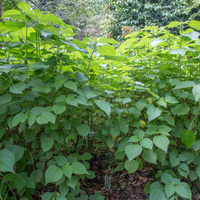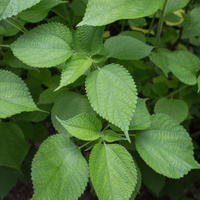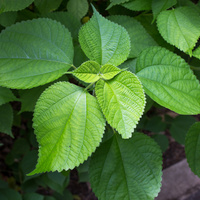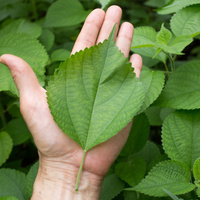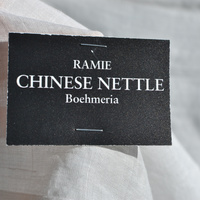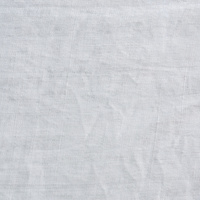Common name: Ramie
Other common names: China grass, Chinese nettle, Chinese silkplant, Ramee
Description
Ramie is a fibre-producing plant originating in India and Southeast Asia, its natural range extending from the Himalayan foothills, through Myanmar (Burma), to Cambodia, Vietnam and China.
It is a perennial sub-shrub with a clumping habit, made up of slender, erect, unbranched stems up to 2.5 m (8 ft) tall sprouting from underground rhizomes.
The leaves attach directly to the stems on long leaf stalks. They are heart-shaped with serrated margins, up to 20 cm (8 in) long and just as wide, deep green and prominently veined on top, silver-grey and softly hairy underneath.
The flowers are small and insignificant, either female or male (on the same plant), borne in separate, very hairy, dense flowering spikes arising at the top of the stems. They are followed by very small, roundish seed.
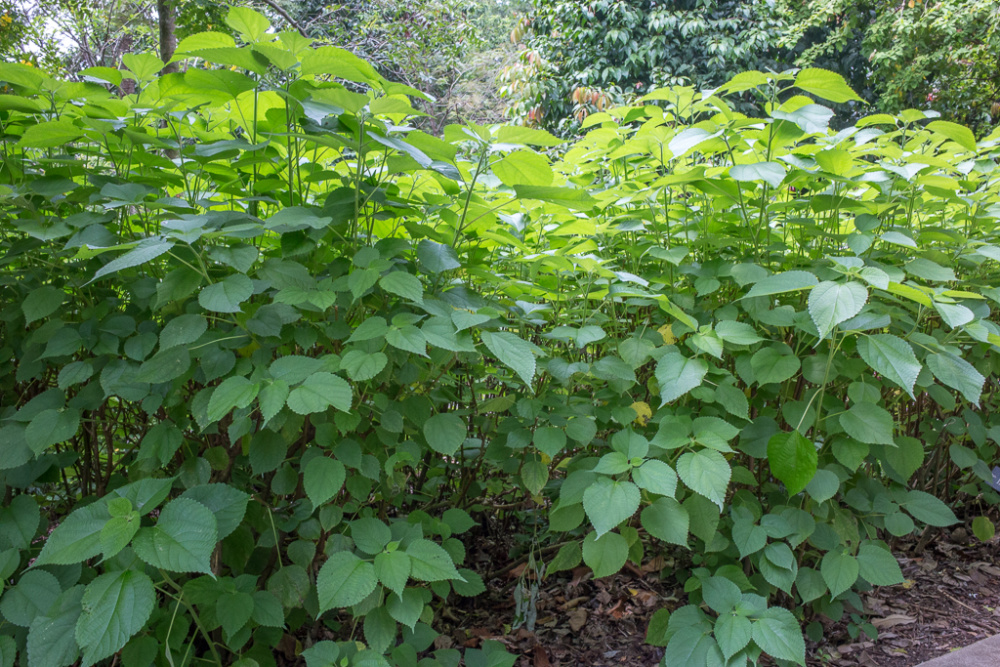
Use
The stems yield a durable, pure-white, lustrous fibre, which is the longest and strongest of all known plant fibres, reportedly up to eight times stronger than cotton. It can absorb and liberate moisture quickly, making it highly suitable for clothing. However, the difficulty in removing the sticky gum that surrounds the fibre is a drawback that has caused it to remain a minor fibre crop.
The fibre has a history of use in textiles for making shirts, suits, underwear, household linens, and a variety of industrial products such as rope, cordage, threads, upholstering, sailcloth, tarpaulins, fire-hoses and belting for machinery. It is also made into pulp used for manufacturing cigarette papers.
The stems are harvested soon after the onset of flowering and are usually harvested two to three times per year. After the stems are cut, the bark is peeled or beaten off. The extracted fibres are then bathed in caustic soda to dissolve the gums, pectins and waxes, then sun-dried to bleach them white.
The leaves, especially the plant tops, are palatable to livestock and are high in protein, with a reported crude protein content of around 20% to 30% of their dry weight.
Climate
Ramie grows naturally and produces quality fibres in humid subtropical and tropical climates, generally areas with annual lows of 13 to 25°C, annual highs of 21 to 35°C, annual rainfall of 1200 to 4000 mm and a dry season of 5 months or less, extending to 12 months with irrigation, such as in Egypt.
Growing
New plants are usually obtained by dividing established clumps into individual plants and then replanting them. Starting plants from cuttings, including rhizome and stem cuttings, is also practised, as are plants raised from seed, but this to a lesser extent.
Performs best on free-draining loam and sand soils of a moderate to slightly acid nature, generally with a pH of 5.5 to 6.5, and on sites with full sun exposure. It is intolerant of slow-draining or waterlogged soils.
Problem features
The seed are tiny and easily dispersed by wind and flowing water, with reports suggesting its spread is mainly concentrated along watercourses. The Hawaii Pacific Weed Risk Assessment (HPWRA) project is assessed as a high-risk species for Hawaii.
Where it grows
References
Books
-
Adams, C. D. 1972, Flowering plants of Jamaica, University of the West Indies, Mona, Greater Kingston
-
Brady, G. S. & Clauser, H. R & Vaccari, J. A. 2002, Materials handbook : an encyclopedia for managers, technical professionals, purchasing and production managers, technicians and supervisors, 15th ed., McGraw-Hill, New York
-
Dastur, J. F. 1964, Useful plants of India and Pakistan : a popular handbook of trees and plants of industrial, economic, and commercial utility, 2nd ed., D. B. Taraporevala Sons, Bombay
-
Dewey, L. H. 1943, Fiber production in the western hemisphere, U. S. Department of Agriculture (USDA), Washington D.C.
-
Fawcett, W. 1891, Economic plants, An index to economic products of the vegetable kingdom in Jamaica, Jamaica Government Printing Establishment, Kingston
-
Ghosh, T. 1983, Handbook on jute, Food and Agriculture Organization of the United Nations (FAO), Rome
-
Gohl, B. 1981, Tropical Feeds : feed information summaries and nutritive values (Revised edition), Food and Agriculture Organization of the United Nations (FAO), Rome
-
Litzenberger, S. C. 1974, Guide for field crops in the tropics and the subtropics, Office of Agriculture, Technical Assistance Bureau, Agency for International Development (USAID), Washington D.C.
-
Macmillan, H. F. 1943, Tropical planting and gardening : with special reference to Ceylon, 5th ed, Macmillan Publishing, London
-
National Research Council (Board on Science and Technology for International Development) 1975, Underexploited tropical plants with promising economic value, National Academic Press, Washington D. C.
-
Randall, R. P. 2002, A global compendium of weeds, R.G. and F.J. Richardson Press, Melbourne
-
Randall, R. P. 2007, The introduced flora of Australia and its weed status, Cooperative Research Centre for Australian Weed Management, Glen Osmond, South Australia
-
Wood, I. M. 1997, Fibre crops : new opportunities for Australian agriculture, Queensland Department of Primary Industries (QLD DPI), Brisbane
